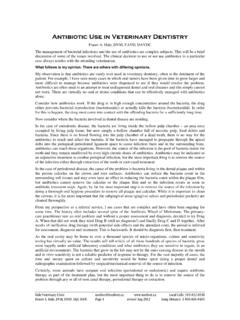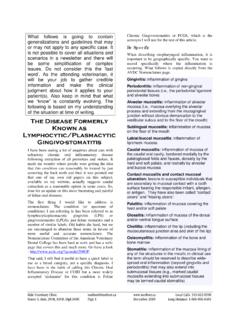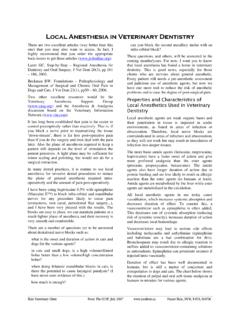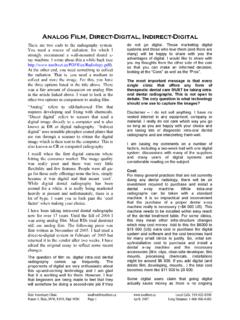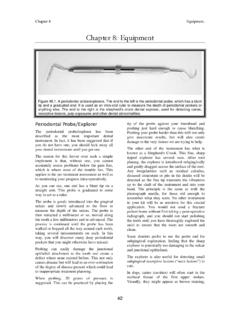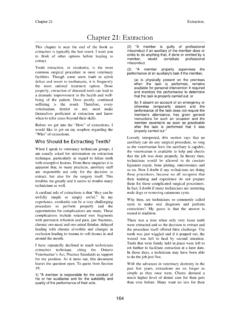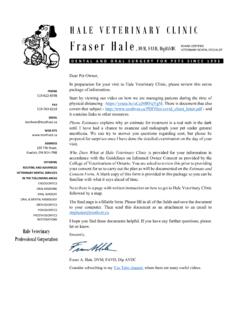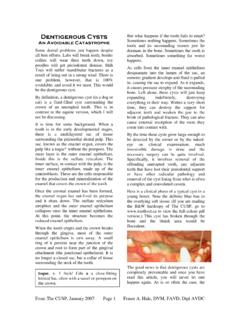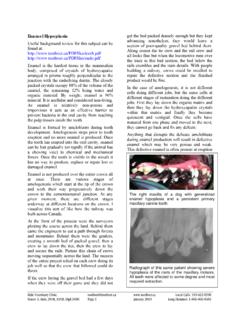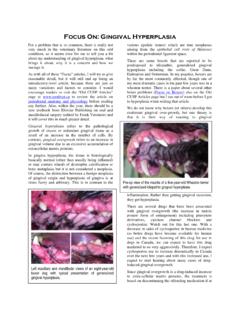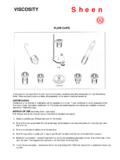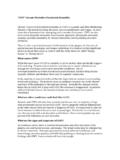Transcription of Focus on: Chronic Ulcerative Paradental Stomatitis …
1 Hale Veterinary Clinic Local Calls: 519-822-8598 Fraser A. Hale, DVM, FAVD, Dipl AVDC Page 1 January 2008 Long Distance: 1-866-866-8483 The CUSP is available as a hard-copy by mail or as a pdf file from our web site. Let us know your preference. Focus on: Chronic Ulcerative Paradental Stomatitis aka CUPS. This is one nasty and frustrating condition! As well as being referred to as CUPS, it may also be called Ulcerative Stomatitis , idiopathic Stomatitis and lymphocytic-plasmacytic Stomatitis . This multiplicity of labels is a reflection of the lack of solid understanding of the cause(s) of the condition. Before going any further we need to make a clear distinction between periodontal disease and Paradental disease. Periodontal disease affects the four periodontal tissues (gingiva, alveolar bone, periodontal ligament and cementum on the root).
2 More on those tissues can be found and reviewed at: The Paradental tissues are the other soft tissues that share the oral cavity with the teeth and which often lie in contact with the crowns of the teeth when the mouth is closed. This includes the oral mucosa, the palatal mucosa, the lining of the buccal pouch, the margins of the lips and the epithelium of the tongue. In many patients, these Paradental tissues can remain relatively healthy even in the face of Chronic and advanced disease of the periodontal tissues. On the other hand, a patient may have severe CUPS with relatively good periodontal health. They really are two separate conditions that may be present on their own or concurrently. Certain breeds such as Maltese terriers and Cavalier King Charles Spaniels are reported as being over-represented and in my own experience, I would say Greyhounds also seem more susceptible than the general population.
3 That said, I have seen the condition in a wide variety of breeds and sizes. Presenting complaints may variably include any or all of: severe halitosis (though you would be surprised what some owners can get used to), excessive drooling of thick, cloudy saliva, lip-fold dermatitis, oral pain and difficulty eating. This first photo is of a mature, rescued Greyhound prior to first treatment. There is certainly periodontal disease with marked, generalized Ulcerative gingivitis and gingival recession at the posterior teeth visible on conscious examination. Note the intense inflammation and ulceration of those areas of oral mucosa that lie against the crowns of the teeth. These are referred to as contact ulcers or kissing ulcers. This next photograph is of the right buccal pouch in a mature German shepherd dog.
4 Again, ulceration and inflammation of the buccal mucosa is apparent. Next, we see contact ulcers just around the area of the maxillary canines and incisors, because the posterior teeth have all been extracted some years prior. This patient is a geriatric Nova Scotia Duck Tolling Retriever. Note the ulceration and inflammation of the palatal mucosa as well. Hale Veterinary Clinic Local Calls: 519-822-8598 Fraser A. Hale, DVM, FAVD, Dipl AVDC Page 2 January 2008 Long Distance: 1-866-866-8483 The CUSP is available as a hard-copy by mail or as a pdf file from our web site. Let us know your preference. The ventral lingual mucosa in this NSDTR s mouth was also ulcerated and inflamed from lying in contact with the mandibular incisors. Yet this edentulous (toothless) area (right mandible) is free of lesions.
5 The differential rule-outs would include various immune-mediated diseases such as the variations of pemphigus and bullous pemphigoid. While these conditions can result in oral lesions, they also often are associated with lesions of the skin and mucous membranes in other areas of the body. Therefore, a thorough examination of the entire patient to look for other areas of involvement should be under-taken. Since the treatment for the immune-mediated diseases is very different from the treatment for CUPS, it is important to make the distinction early on in the management of the case. As well as a complete physical examination, CBC and biochemistry are good to have pre-operatively. The only laboratory findings typically associated with CUPS is a (polyclonal) hypergammaglobulinemia and a mild neutrophilic leukocytosis, so any other abnormalities should be assessed in their own right before anesthetizing the patient.
6 While a biopsy of the affected tissues would be a good thing to have, to rule out an auto-immune disease, this requires and anesthetic and so I would always suggest that far more than a biopsy be done at that time. While the specific pathogenesis of CUPS remains unknown, it is helpful to consider that, for whatever reasons, these animals are unable to tolerate the presence of bacterial plaque on the crowns of their teeth. Even fairly minor plaque accumulations result in an over-blown, destructive (and painful) Ulcerative inflammatory response. Therefore the Focus of the management of CUPS must be scrupulous plaque control. Starting on page three of you will find a brief explanation of plaque and the rest of this package discusses various plaque-control strategies and challenges.
7 Following a complete physical examination, CBC and biochemical profile, if things are pointing to CUPS, the next step is a COHAT (comprehensive oral health assessment and treatment). This starts with a detailed examination, probing and charting of each and every tooth along with whole-mouth intra-oral dental radiographs. All teeth with significant periodontal disease (pocketing, bone loss, furcation exposure) or endodontic disease should The only lab finding typically associated with CUPS is a (polyglonal) hypergammaglobulinemia, as expected with any Chronic inflammatory disease. Hale Veterinary Clinic Local Calls: 519-822-8598 Fraser A. Hale, DVM, FAVD, Dipl AVDC Page 3 January 2008 Long Distance: 1-866-866-8483 The CUSP is available as a hard-copy by mail or as a pdf file from our web site.
8 Let us know your preference. be extracted. Selective extraction in areas of crowding (that would be plaque-retentive) would also be indicated. All extraction sites are sutured with an absorbable monofilament (I favor 5-0 and 4-0 Monocryl ). The remaining teeth are then cleaned thoroughly above and below the gum line. This is also when you would get your biopsies. Then polishe and lavage. In areas where it is available, I would recommend applying a coat of Merial s Ora-Vet , which is a waxy coating for the teeth that will inhibit bacterial recolonization of the crowns of the teeth ( ). At the time of writing, this product is not available in Canada. The next phase is tricky. In most cases, the patient will have had some extractions and we need those sites to heal. Also, the mouth has already been sore for a long time and so the animal is going to be mouth-shy.
9 Therefore, I do not want the owners touching the mouth at all for two weeks. I don t want the owners causing the animal further pain and I do not want them applying any pressure or tension on the incisions as this may disrupt healing. I do want the patient on analgesics for several days post op and I will probably also dispense antibiotics (I send antibiotics home only rarely, but these cases do call for it). Since I don t want the owners handling the mouth, the medications must be taken voluntarily by the patient and so must be in a form or disguised in a way that the animal will gladly ingest them. Following a two-week healing period we hit the even trickier part. The owner must now institute a very aggressive plaque control program or you can expect the patient s condition to return to pre-op status within a very short time.
10 The most effective way to do this is for the owners to brush the teeth daily with a nylon-bristled tooth brush. As the Home Care documents previously cited indicate, it is the mechanical action of the tooth brush that does the work. All the rinses and gels and pastes and water additives in the world will not control plaque to a sufficient degree to do the job in these patients. They may be useful adjuncts, but the toothbrush is the cornerstone of this program and must be used daily. No rinse, paste, gel or water-additive will come close to keeping CUPS under control if not used with the daily application of a tooth brush. As well as daily brushing, the weekly application of the home care version of Ora-Vet (where available) is indicated. When dietary issues do not preclude it, I would also recommend feeding a diet shown to aid in the reduction of plaque.
